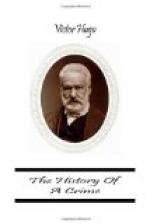At the corner of the Rue du Sentier an officer of Spahis, with his sword raised, cried out, “This is not the sort of thing! You do not understand at all. Fire on the women.” A woman was flying, she was with child, she falls, they deliver her by the means of the butt-ends of their muskets. Another, perfectly distracted, was turning the corner of a street. She was carrying a child. Two soldiers aimed at her. One said, “At the woman!” And he brought down the woman. The child rolled on the pavement. The other soldier said, “At the child!” And he killed the child.
A man of high scientific repute, Dr. Germain See, declares that in one house alone, the establishment of the Jouvence Baths, there were at six o’clock, beneath a shed in the courtyard, about eighty wounded, nearly all of whom (seventy, at least) were old men, women, and children. Dr. See was the first to attend to them.
In the Rue Mandar, there was, stated an eye-witness, “a rosary of corpses,” reaching as far as the Rue Neuve Saint Eustache. Before the house of Odier twenty-six corpses. Thirty before the hotel Montmorency. Fifty-two before the Varietes, of whom eleven were women. In the Rue Grange-Bateliere there were three naked corpses. No. 19, Faubourg Montmartre, was full of dead and wounded.
A woman, flying and maddened, with dishevelled hair and her arms raised aloft, ran along the Rue Poissonniere, crying, “They kill! they kill! they kill! they kill! they kill!”
The soldiers wagered. “Bet you I bring down that fellow there.” In this manner Count Poninsky was killed whilst going into his own house, 52, Rue de la Paix.
I was anxious to know what I ought to do. Certain treasons, in order to be proved, need to be investigated. I went to the field of murder.
In such mental agony as this, from very excess of feeling one no longer thinks, or if one thinks, it is distractedly. One only longs for some end or other. The death of others instills in you so much horror that your own death becomes an object of desire; that is to say, if by dying, you would be in some degree useful! One calls to mind deaths which have put an end to angers and to revolts. One only retains this ambition, to be a useful corpse.




